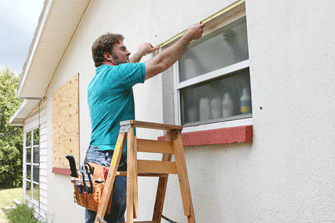Every year, your family should review your hurricane plan and make changes as necessary. If you plan to evacuate, your plan should include where you will go, the route to get there, when you will leave and what to take with you, and what preparations you will make to your home.
If you plan to stay, make sure that you have all of the supplies necessary to be on your own for at least 72 hours. If you are planning to go to an evacuation shelter, have your shelter supplies kit packed and ready. Make sure that you have all the materials on hand to protect your home and that you prepare your home no later than when a hurricane warning is issued. You should also trim dead wood and limbs from your trees. Don't forget to make arrangements for your pets.
If a storm is threatening the area, listen to local media for information and actions to be taken. In addition you should:
- Fuel your vehicle. You will need it if the storm hits and power is out.
- Bring in outdoor objects such as lawn furniture, toys and garden tools.
- Install your storm shutters or plywood and secure all doors.
- Prepare boats as appropriate.
- Turn up refrigerators and freezers to their coldest settings.
- Turn off small appliances that are not needed.
- If you evacuate, turn off your air conditioner. If you stay at home and the power goes off, turn off your air conditioner. Turn it back on only after power has been restored in your area.
- Turn off all LP tanks.
- Fill sinks and bathtubs with water.
- Get an extra supply of cash. Banks and ATM's may not be operational immediately after the storm. Call an out of town friend or family member to let them know of your plans. Then instruct other family members to call that person for information about your family after the storm. It is usually easier for you to call out of the area after a storm than it is for others to call into the area.
|
Tracking a Storm
When tracking a storm, it is important to remember that a hurricane is not a point on a map. The coordinates that are provided by the National Hurricane Center only indicate the location of the center or eye of the storm. Some hurricanes have tropical storm force winds over 200 miles from the center, and hurricane force winds 75 miles or greater from the center. It is these wind fields that should be tracked. The center of the storm may make landfall 50 - 100 miles away from this area. However, strong winds, storm surge, and heavy rains may cause severe damage locally.
It is also important to recognize that hurricane forecasting is not an exact science and that there is a significant margin of error, especially at long range, in forecasting the area of landfall for a storm. Over the past 10 years, the margin of error in forecasting landfall is over 250 miles, 72 hours before landfall. That margin of error is still over 75 miles, 24 hours before landfall. Due to the long evacuation clearance times for this area, evacuation orders may have to be issued 48 hours or more before landfall.
Watches and Warnings
(Official Watches and Warnings are issued by the National Hurricane Center)
Tropical Storm Watch
Issued when tropical storm conditions (39 - 73 mph winds) are possible in the specified watch area, usually within 36 hours.
Tropical Storm Warning
Issued when tropical storm conditions (39 - 73 mph winds) are expected in the specified warning area, usually within 24 hours.
Hurricane Watch
Issued when hurricane conditions (74 mph or greater winds) are possible in the specified watch area, usually within 36 hours. During a hurricane watch, be prepared to take immediate action to protect your family and property in case a hurricane warning is issued.
Hurricane Warning
Issued when hurricane conditions are expected in the specified warning area, usually within 24 hours. Storm preparations should be completed.
BeReadyEscambia.com ©2014 |